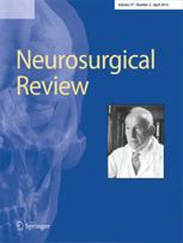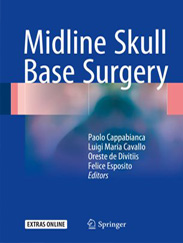




福洛里希教授(Sebastien Froelich)是世界知名的神经外科内镜手术专家,他对于脊索瘤、脑膜瘤、垂体瘤、颅咽管瘤等都有大量的临床治疗经验,提出了克服脊索瘤的颅底基础方法、鼻内镜和下鼻甲联合皮瓣修复扩大鼻内入路后大面积颅底缺损的手术方法。
福洛里希教授(Sebastien Froelich)尤其擅长神经内镜鼻内入路的颅底肿瘤切除,针对垂体瘤、脊索瘤、复杂脑肿瘤等采取神经内镜下颅内高难度位置的微创手术。其发明的内镜手术“筷子”操作方式不止提高了肿瘤的切除率,更是使肿瘤患者有了更好的预后效果。
福洛里希教授(Sebastien Froelich)专注于内窥镜鼻内解剖学,在1999年–2000年,以及2005年–2006年在辛辛那提大学获得颅底研究奖学金,是法国巴黎Lariboisiere大学医学博士。由于在颅底肿瘤手术及神经内镜手术中的贡献,Froelich教授受邀成为全球50多家医学院的课程主任和讲师。开展海绵窦解刨学、内镜治疗颅咽管瘤、颅颈交界处的手术方法等重要讲座,供医学学者进行共同研究学习。
福洛里希教授(Sebastien Froelich)不仅有丰富的临床治疗经验,更是针对病症的特点能有效的进行突破性研究,为治疗提供有效的支撑,促进神经外科治疗的发展。福洛里希教授(Sebastien Froelich)以作者或合著者身份在学术杂志及书籍上发表了60多篇文章。

颅底脊索瘤由于其罕见性,医学上有一定的治疗困难,福洛里希教授(Sebastien Froelich)使用通过鼻子和蝶窦的自然路径治疗改善了颅底脊索瘤复发率和死亡率,同时还具有很好的切除率,没有出现新的永久性神经功能缺损。该研究为医学界提供了有效的数据,促进了脊索瘤治疗的进步。

脊索瘤是一种罕见的肿瘤,被认为是低中度恶性肿瘤,起源于脊索细胞。脊索瘤的发病率估计约为每百万人中0.51-0.80例。福洛里希教授(Sebastien Froelich)提出的基本策略是尽可能达到极大限度的肿瘤切除,同时保持神经功能和生活质量。外科手术是为保护重要的神经结构和功能而量身定做的。在那些由于病变程度而无法进行根治性切除的病例中,手术的目的是在尽可能减少体积,以便于术后放射治疗并提高其疗效。
2018年9月22日,福洛里希教授(Sebastien Froelich)在INC的邀请下,在上海参加以复杂颅底肿瘤的显微手术和内镜手术入路,岩骨斜坡脑膜瘤治疗策略为议题的学术沙龙活动。在讲述内镜手术操作要点的同时与患有黑色素瘤的一名小患者进行会面,给出了专业及先进手术方案的建议。
2018年11月24日,世界神经外科顾问团年度峰会上,世界神经外联合会(WFNS)颅底手术委员会主席,欧洲颅底学会执行委员会成员福洛里希教授(Sebastien Froelich)作了《颅底和颅颈交界脊索瘤的手术策略》的演讲,作为神经内镜及颅底手术的优秀专家,福洛里希教授(Sebastien Froelich)将新的临床案例视频融入演讲,生动直观得展示除出了高水平内镜手术技能。
1. Minimally invasive transpalpebral "eyelid" approach to the anterior cranial base. (经“眼睑”微创入路到达前颅底)
2. Large sphenoid wing meningiomas involving the cavernous sinus: conservative surgical strategies for better functional outcomes. (累及海绵窦的蝶骨大翼脑膜瘤:保守的手术策略以获得更好的功能结果)
3. Surgery and protontherapy in Grade I and II skull base chondrosarcoma: A comparative retrospective study. (I级和II级颅底软骨肉瘤的手术和质子治疗:一项回顾性比较研究)
4. Anterior inferior petrosectomy: defining the role of endonasal endoscopic techniques for petrous apex approaches. (前下岩锥切除术:定义内镜技术在岩尖入路中的作用)
5. Management Scheme for Cerebral Wegener Granulomatosis: An Unusual Pseudotumoral Skull Base Pathology. (脑韦氏肉芽肿病的治疗方案:一种罕见的假性肿瘤颅底病理学)
6. Endoscopic endonasal approach in the management of skull base chordomas--clinical experience on a large series, technique, outcome, and pitfalls.. (经鼻内镜入路治疗颅底脊索瘤-一系列临床经验,技术、结果和困难)
7. Cellular magnetic resonance imaging for the differentiation of infectious and degenerative vertebral disorders: preliminary results. (用于区分感染性和退行性椎体疾病的细胞磁共振成像:初步结果)
8. Cystic meningioma: radiological, histological, and surgical particularities in 43 patients. (囊性脑膜瘤:43例患者的放射学,组织学和手术特性)
9. Endoscopic, endonasal variability in the anatomy of the internal carotid artery. (内镜经鼻检查颈内动脉解剖变异)
10. Surgical Anatomy for the Endoscopic Endonasal Approach to the Ventrolateral Skull Base. (内镜经鼻入路到达颅底腹外侧的手术解剖)
11. Ethmoidal adenocarcinoma treated by exclusive endoscopic approach: Focus on learning curve and modification of management. (单纯内镜治疗筛窦腺癌:注重学习曲线和改进治疗方法)
12. Endoscopic Approach of the Insula Through the Anterior Middle Temporal Gyrus: A Feasibility Study in the Laboratory. (经颞前中回岛叶内镜入路:实验室可行性研究)
13. Chordomas: A Review. (脊索瘤:回顾)
14. Anatomy of the inferior orbital fissure: implications for endoscopic cranial base surgery. (眶下裂的解剖:内镜下颅底手术的意义)
15. Prognostic and Therapeutic Markers in Chordomas: A Study of 287 Tumors. (脊索瘤的预后和治疗标志物:287个肿瘤的研究)
16. Anterior communicating artery aneurysm clipped via an endoscopic endonasal approach: technical note. (内镜经鼻入路夹闭前交通动脉瘤:技术说明)
17. Exposure of the distal cervical segment of the internal carotid artery using the trans-spinosum corridor: cadaveric study of surgical anatomy. (经trans-spinosum走廊暴露颈内动脉的远端颈段:手术解剖学的标本研究)
18. Initial experience using awake surgery for glioma. (术中唤醒治疗胶质瘤的初步经验)
19. Refinement of the extradural anterior clinoidectomy: surgical anatomy of the orbitotemporal periosteal fold. (硬膜外前斜坡切除术的改良:眶后骨膜褶皱的手术解剖)
20. Proton beam therapy for skull base chordomas in 106 patients: A dose adaptive radiation protocol. (106名颅底脊索瘤患者的质子束治疗:剂量自适应放疗方案)
21. Anatomic study of the prechiasmatic sulcus and its surgical implications. (交叉前沟的解剖学研究及其外科意义)
22. Spontaneous regression of meningiomas after interruption of nomegestrol acetate: a series of three patients. (脑膜瘤停用醋酸诺美孕酮后的自发消退:3例患者)
23. The Medial Extra-Sellar Corridor to the Cavernous Sinus: Anatomic Description and Clinical Correlation. (海绵窦内外侧走廊:解剖学描述和临床相关性)
24. The Chopsticks Technique for Endoscopic Endonasal Surgery-Improving Surgical Efficiency and Reducing the Surgical Footprint. (鼻内镜手术的筷子技术-提高手术效率和减少手术痕迹)
25. Clivus chordomas: a systematic review and meta-analysis of contemporary surgical management. (斜坡脊索瘤:当代手术治疗的系统回顾和荟萃分析 )
26. Prognostic and therapeutic markers in chordomas: a study of 287 tumors. (脊索瘤的预后和治疗标志物:对287例肿瘤的研究)
27. Neuronavigated Fiber Dissection with Pial Preservation: Laboratory Model to Simulate Opercular Approaches to Insular Tumors. (保留软脑膜的神经导航纤维解剖:模拟岛叶肿瘤手术方法的实验室模型)
28. Hydroxyapatite bone cement application for the reconstruction of retrosigmoid craniectomy in the treatment of cranial nerves disorders. (羟基磷灰石骨水泥(HAC)在治疗颅神经疾病的乙状窦后颅骨切除术重建中的应用)
29. The effect of extent of resection on recurrence in patients with low grade cerebral hemisphere gliomas. (切除范围对低级别大脑半球胶质瘤患者复发情况的影响)
30. Chordomas and cartilaginous tumors at the skull base. (颅底脊索瘤和软骨肿瘤)